Most birders when visiting Fuerteventura probably have a "hit list" of four key species: Fuerteventura Chat, Houbara Bustard, Cream-coloured Courser, Black-bellied Sandgrouse. Alongside these may be placed Marbled Duck, Trumpeter Finch, Ruddy Shelduck, Plain Swift, Stone Curlew, Berthelot’s Pipit, the degener race of Blue Tit (treated as a separate species by some authorities), and Barbary Partridge. A series of recent winter visits by myself and my father to Fuerteventura on three occasions (and Lanzarote, four occasions) has enabled me to observe these species and to assess the best places to look for them – indeed the best birding sites on the island.
Descriptions of the ‘best’ sites to see each species will be given for those who visit with a hit list, and throughout I will refer frequently to the so-called ‘bible’ of birding the Canary Islands, ‘A Birdwatcher’s Guide to the Canary Islands’ by Tony Clarke and David Collins (published in 1996) – however this is by no means a perfect guide.
I will start with the big four, Fuerteventura Chat, Houbara Bustard, Cream-coloured Courser and Black-bellied Sandgrouse, then go on to describe sites to see other ‘specials’.
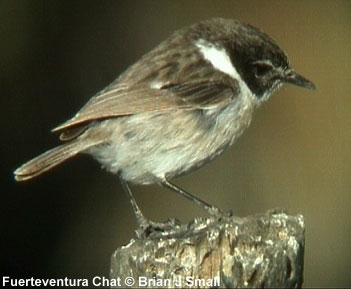
Fuerteventura Chat
Fuerteventura Chat (or Canary Islands Stonechat) was discovered in 1888 by E. G. Meade-Waldo, and is most frequently encountered in hilly areas, most notably in steep valleys and dry or nearly dry wadies (locally known as barrancos). It is said to be found locally along the coast in the south, edges of some lava fields and around the areas of permanent water, however, I suspect that the need for rocky slopes with fairly well developed vegetation or semi-desert scrub is the main requirement.
Surprisingly, and unlike Common Stonechat, I found Fuerteventura Chat to be quite secretive and quiet, on windy days they spent a lot of time amongst quite bushy vegetation; no call was heard and only a brief snip of sub-song was noted on one occasion. I found them at only three sites: Los Molinos, both along the edge of the reservoir and in the barranco below the dam; at Las Penitas, although this site has been disturbed with a pointless track bull-dozed along the valley bottom, destroying a lot of the habitat; and Barranco de la Torre. Most of my observations were made at the last location, south of El Castillo, where I found six pairs in and around a kilometre-long section of tamarisk and palm trees at the bottom of the barranco. This must now be the most accessible site for the species on Fuerteventura and possibly should be protected – there doesn’t appear to be any form of habitat protection anywhere on Fuerteventura, other than for hunting.
Access is from the main coast road about one km from where it turns inland from Salinas del Carmen. Turn left off the main road on a track by a white building; park immediately and follow the track that leads to the valley bottom. The chats were easily located on the northern side of the valley by the rows of date palms and scrub around them. They may be located by the behaviour of Sylvia warblers, Sardinian and Spectacled Warblers, in the area that follow them vociferously in a similar manner to that of Dartford Warblers following Stonechats in Britain.
Along the barranco there are pools of water and these attract a number of species: in Jan/Feb 2001 they held a pair of Ruddy Shelduck, Spoonbill, various warblers and waders, whilst Black-bellied Sandgrouse and Barbary Partridge were noted in the area, no doubt using the pools to drink and bathe.
Other locations in the ‘Birdwatchers Guide’ given for the chat were not visited in 2001, but it should be noted that access to some sites has changed. For example, access at Barranco de Rio Cabras, the barranco north of the airport, is very difficult now that the main coast road is dual carriageway and parking is impossible. I would also say that there are signs of increased disturbance along a number of barrancos cause by the Fuerteventurans insatiable appetite for digging, whether it’s roads or tracks or simply clearing the habitat so that they can dump rocks from tourist site development. Even along Barranco de la Torre there is now a track pushed through the bottom of the wadi.
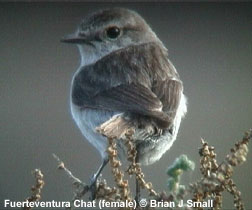
Houbara Bustard
A number of sites are given in the ‘Guide’. The best and most interesting site, because of other species also to be found readily, is that of the plains at La Pared/Costa Calma. Here we found a maximum of nine in one group, with early morning essential if good views, without heat haze, are to be obtained.
Turn north towards La Pared near Km63, drive north up the hill to the white sign, branch off left up a track, then turn left along another track to park after about a kilometre by the fence. The best way to find Houbara Bustard is to look NW down the slope towards the sea. On two occasions this year I found Houbaras using this method - on the second there were nine.
There are other sites, indeed the north is actually said to be better, but despite searching I couldn’t locate any at La Oliva or on the plains near Los Molinos reservoir – although they have been noted at these sites on previous visits. In the ‘Guide’ the area near Caleta des Fustes is given, but disturbance here, due to construction work on holiday complexes and a golf course, is so great that you would be lucky.
Beside the problem of heat haze on the plains near La Pared, a number of people walk across the plains during the day to visit the beaches on the west-facing coast, so disturbance can be annoying. An early start is helpful.
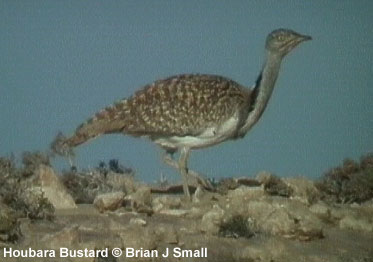
Cream-coloured Courser
We found coursers at three sites, with a total of c.50 birds: on the plains near Los Molinos; SW of La Oliva - a group of 15; and on the plains near La Pared – two groups totalling c.30 birds. One aspect of their behaviour is the congregation into groups that range over a wide area.
Again, the best method is to find a vantage point on the ridge on the plains near La Pared and scan the area looking NW towards the sea. Sometimes, by sitting still, a group may run up the hill towards you and go right past you, giving great views. However, usually I found them to be pretty elusive.

Black-bellied Sandgrouse
Like the courser, I found the sandgrouse at a number of sites - La Oliva, Barranco de la Torre – but by far the best, and possibly one of the best anywhere in the Western Palaearctic, were the plains at La Pared/Costa Calma.
On the first visit, mid-morning, I had a large number (over 100) flying onto the plains from the NW, presumably having been drinking or bathing; on the second occasion, early in the morning a few were noted on the ground, but most were flying towards the NW. I presumed that these were going to drink and so drove to La Pared, finding groups flying in to drink and bathe in the gullies containing fresh water near the beach car park.

Rather than visit briefly, these birds stayed to preen until at least 1100hrs, before leaving. At any one time up to 100 could be seen. Once they had flown off, I went to find how long the site might have been used and the amount of droppings would suggest that it was a regular site. Care needs to be taken not to disturb them, but excellent views may be obtained.
Comments on other species and other sites

There are still Marbled Ducks and Ruddy Shelducks on Fuerteventura, at Los Molinos, but it appears that the numbers are declining. I found four Marbled Ducks, with the head-bobbing display observed, and a maximum of five Ruddy Shelduck, but I suspect the numbers were augmented by the birds from Barranco de la Torre.
Berthelot’s Pipits and Trumpeter Finches were abundant everywhere in Jan/Feb 2001, with the latter species clearly having had a very good breeding season (flocks of over 150 were noted at several sites). The best views of Trumpeter Finch were had on the cliffs north of El Castillo, where feeding of the Barbary Ground Squirrels had tamed the finches somewhat, and they came to c.2m at times.
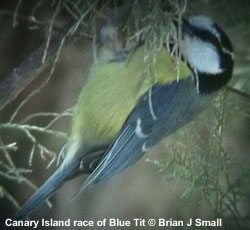
The eastern Canary Island race of Blue Tit, degener, is well worth a look – considering its treatment as a possible full species in some quarters, and the best site is the Betancuria/Vega de Rio Palmas area. At Betancuria they occur and sing openly in the town, especially around the café near the church – the ‘Guide’ also reports that they may be seen at La Oliva, but despite searching we couldn’t locate any . They are very smart, resembling the NW African race, and their voice is remarkably different to that of the Blue Tits from Europe.
Plain Swift is described as resident, but scarce on the eastern islands. I found on both Lanzarote and on Fuerteventura that there is a probability that it is not resident, and that it may be absent for a short spell. In February 1999, on Lanzarote, they were absent until mid month, then arrived in small numbers (seen flying in off the sea) and subsequently seen uncommonly throughout the island. This pattern was repeated on Fuerteventura in 2001, when all swifts were absent until their arrival in early February, then could be found scarcely along some barrancos, but most notably at Los Molinos. Obviously, care in their identification is needed, and this is further increased by the knowledge that both Pallid and Common Swifts arrive at the same time – with Pallid the most common.
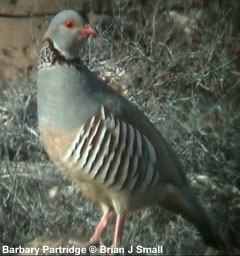
Other more common species, will be ‘bumped into’ anywhere: Barbary Partridge was seen well at Barranco de la Torre and Las Penitas – is very much more common on Fuerteventura than Lanzarote; Lesser Short-toed Larks are abundant in the right areas, and apart from singing birds huge flocks form and sweep across the plains (the biggest flock was c.600); Egyptian Vultures cover large areas and are seen occasionally – we noted them at Pozo Negro (a regular pair that sometimes sit on the cliffs and hills north of the village), in the mountains around Betancuria, and the only immature was from the main road that crosses the Malpais Grande; Barbary Falcon also covers large areas, in 2001 we saw a large falcon in the hills east of La Lajita which was probably this species, they had previously been noted at this site.

In reality, due to the extremely poor coverage, anything might turn up, within reason. In Jan/Feb 2001, I found 77 species, with the highlights being: an adult Spotted Sandpiper and Common Gull at Salinas del Carmen; there was a flock of eight Ring Ouzels of the race alpestris at Vega de Rio Palmas; a Fieldfare, Common Stonechat and Chaffinch at Caleta des Fustes (another Chaffinch was noted at the ‘woods’ at Costa Calma); three Little Shearwaters were seen from El Castillo in strong NE winds on 30th January; a juvenile Booted Eagle caused a bit of disturbance at Los Molinos on 2nd February.
A last word on the birds, from a gull freak: anyone wanting to study the local Yellow-legged Gulls will obviously see them very commonly, but the best gathering is at the dump on the north side of Puerto del Rosario. An article on the race (presumed to be atlantis) will appear in the near future on Surfbirds.
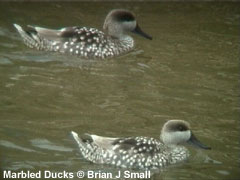
Brian Small
March 2001